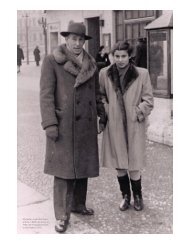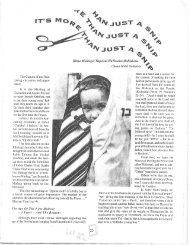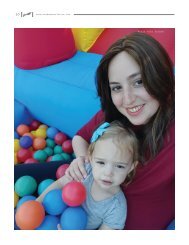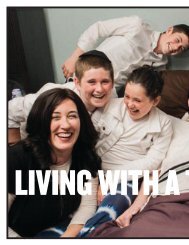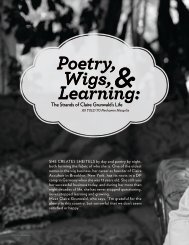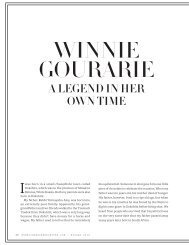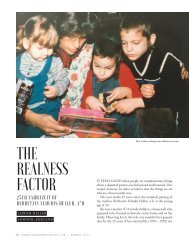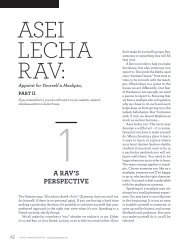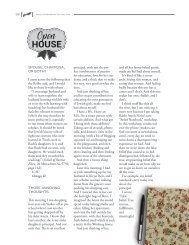The Male Brain And Exercise
The Male Brain and Exercise, by Sara Chana Silverstein, September 2012
The Male Brain and Exercise, by Sara Chana Silverstein, September 2012
You also want an ePaper? Increase the reach of your titles
YUMPU automatically turns print PDFs into web optimized ePapers that Google loves.
PHOTO CREDIT: devorahgoldstein.com<br />
V{|Çâv{ S ECTION<br />
<strong>The</strong> <strong>Male</strong> <strong>Brain</strong><br />
<strong>And</strong> <strong>Exercise</strong><br />
WWW.NSHEICHABADNEWSLETTER.COM SEPTEMBER 2012 0
N eurologists say boys need to move. <strong>Brain</strong> researchers<br />
say that boys need to exercise to reach their full potential.<br />
Moving is how boys learn to solve problems, the way<br />
they play, the way they communicate and the way they remember<br />
the things they learn.<br />
You don’t have to be a brain science researcher to know<br />
that when boys are little their lives are all about action and adventure.<br />
Boys are programmed to make things move, and<br />
watch things move.<br />
Scientists used to think this “boy behavior” was the result<br />
of socialization, but they now know that the greater motivating<br />
factor for boys needing to move is biologically wired into<br />
the male brain.<br />
Researchers studied boys and girls to see how they<br />
solved math problems and how long it took them. When the<br />
boys were solving the math problems they would swing their<br />
legs back and forth or wiggle their feet. When the boys were<br />
asked to explain how they solved the math problems, they<br />
squirmed, twisted, turned, and gestured with their hands and<br />
arms to explain how they got the answer. <strong>The</strong> boys were able<br />
to solve the problems more quickly than the girls and a lot of<br />
their speed was attributed to the movements the boys used to<br />
solve the math problems. (Maybe this explains why boys<br />
“shuckle” when they learn.)<br />
Girls didn’t move as they solved the problems and although<br />
their math scores were about the same as the boys, it<br />
took their brains longer to calculate the problems. Unlike<br />
girls, boys create memory best with the assistance of movement.<br />
<strong>Male</strong> and female brains are different from the moment<br />
of conception. Although the cells and neurons are the same in<br />
boys and girls, boys learn things differently than girls.<br />
When boys exercise, their brains work more effectively.<br />
Boys who exercise perform better on tests, retain what<br />
they’ve learned and are calmer, more patient, and less<br />
stressed.<br />
It was once believed that a person was born with a certain<br />
amount of neurons in the brain and that is what they had<br />
for life. Now it is known that new neurons can be created and<br />
exercise is one of the best ways to get them.<br />
<strong>Exercise</strong> influences learning directly, at the cellular level,<br />
V{|Çâv{ S ECTION<br />
S A R A C H A N A S I L V E R S T E I N<br />
International Board Certified Lactation Consultant (IBCLC), Registered Herbalist, American Herbalists Guild (RH, AHG)<br />
Girls wil be girls, right from the start.<br />
Boys who exercise perform<br />
better on tests, retain what<br />
they’ve learned and are calmer,<br />
more patient, and less<br />
stressed.<br />
WWW.NSHEICHABADNEWSLETTER.COM SEPTEMBER 2012 0
improving the brain’s potential to log in and process new information.<br />
According to the researcher Dr. Carl Cotman,<br />
“One of the prominent features of exercise, which is sometimes<br />
not appreciated in studies, is an improvement in the<br />
rate of learning… Studies suggest that if you’re in good<br />
shape you will be able to learn and function more efficiently.”<br />
What does exercise do to help with learning? Scientists<br />
do not have all the answers yet but they have discovered that<br />
there is a chemical in the brain called brain-derived neurotrophic<br />
factor (BDNF) that helps with memory. BDNF<br />
gives the synapses in the brain the tools they need to take in<br />
information, process it, associate it, remember it, and put it<br />
in context. BDNF is created when people exercise. Studies<br />
have shown that when people were given a list of words to<br />
memorize after exercising, they retained the information better<br />
and could recall the words better than the group given the<br />
words to memorize without exercising first.<br />
After exercise a person has about three hours to use this<br />
chemical to create a new memory. What does this mean? If<br />
a person jogs or takes a 20 minute brisk walk and then learns<br />
some vocabulary words, he or she will be able to remember<br />
them better.<br />
A notable experiment in 2007 showed that cognitive<br />
function improves after just one 35-minute session on a<br />
treadmill.<br />
We used to think that the brain was a mass of tissue that<br />
basically stayed dormant, but now we know that the brain is<br />
more like play-doh. It is an adaptable organ that can be<br />
V{|Çâv{ S ECTION<br />
molded by input in much the same way as a muscle can be<br />
sculpted by lifting barbells. <strong>The</strong> more you use it, the stronger<br />
and more flexible it becomes. <strong>Brain</strong> flexibility is an important<br />
function that reflects our ability to shift thinking and to<br />
produce a steady flow of creative thoughts. <strong>The</strong> brain works<br />
like all the other parts of our body: use it or lose it. For the<br />
brain to reach its full potential, we now know that not only<br />
is reading and studying important, there is another critical<br />
ingredient, and that is physical exercise. Exercising without<br />
learning is not going to build intelligence, but learning without<br />
exercising will not allow the brain to reach its full potential,<br />
especially for boys!<br />
In a yeshivah in upstate New York, there were two<br />
eighth grade rebbis. One insisted that his students play vigorous<br />
basketball or another sport for a half hour before opening<br />
their Gemaras in the afternoon. <strong>The</strong> other discouraged<br />
sports and wanted the boys to memorize Mishnayos or review<br />
what they had learned during the half-hour mid-afternoon<br />
break. Which class do you think covered more Gemara<br />
and knew it better? I’ll leave you with that… You may want<br />
to make sure your son’s rebbi reads this article!<br />
Please note: <strong>Exercise</strong> can and does benefit girls too, although<br />
perhaps in a different way than boys. Lack of exercise<br />
in girls has detrimental effects as well, but not necessarily inability<br />
to retain or process information learned. <br />
_________________<br />
Sara Chana Silverstein is a mother of seven, a lactation consultant, registered<br />
herbalist and classical homeopath. She currently writes regular<br />
columns in many national magazines and has recently been interviewed<br />
on shows such as CBS and NBC news. Visit her website, sarachana.com,<br />
for more information on birth, breastfeeding and children’s health.<br />
WWW.NSHEICHABADNEWSLETTER.COM SEPTEMBER 2012 0






